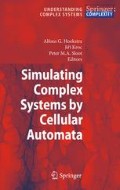Abstract
Evolutionary algorithms (EAs) are a family of heuristic search methods that are often used nowadays to find satisfactory solutions to difficult optimization and machine learning problems. EAs are loosely based on a few fundamental evolutionary ideas introduced by Darwin in the nineteenth century. These concepts revolve around the notion of populations of organisms adapting to their environment through genetic inheritance and survival of the fittest. Innovation is provided by various biological recombination and mutation mechanisms. EAs make use of a metaphor whereby an optimization problem takes the place of the environment; feasible solutions are viewed as individuals living in that environment and an individual’s degree of adaptation to its surrounding environment is the counterpart of the objective function evaluated on a feasible solution. In the same way, a set of feasible solutions takes the place of a population of organisms.
Access this chapter
Tax calculation will be finalised at checkout
Purchases are for personal use only
Preview
Unable to display preview. Download preview PDF.
References
A.E. Eiben, J.E. Smith. Introduction to Evolutionary Computing. (Springer Heidelberg, 2003)
M. Gorges-Schleuter. ASPARAGOS an asynchronous parallel genetic optimisation strategy, ed. by J.D. Schaffer, Proceedings of the Third International Conference on Genetic Algorithms, Morgan Kaufmann, San Fransisco, CA, pp. 422–427 1989
B. Manderick, P. Spiessens, Fine-grained parallel genetic algorithms, ed. by J.D. Schaffer, Proceedings of the Third International Conference on Genetic Algorithms, Morgan Kaufmann, San Fransisco, CA, pp. 428–433 1989
W.D. Hillis, Co-evolving parasites improve simulated evolution as an optimization procedure. Physica D 42, 228–234 (1990)
R.J. Collins, D.R. Jefferson, Selection in massively parallel genetic algorithms, ed. by R.K. Belew, L.B. Booker, Proceedings of the Fourth International Conference on Genetic Algorithms, Morgan Kaufmann, San Francisco, CA, pp. 249–256 1991
Y. Davidor, A naturally occurring niche & species phenomenon: The model and first results, ed. by R.K. Belew, L.B. Booker, Proceedings of the Fourth International Conference on Genetic Algorithms, Morgan Kaufmann Publishers, San Mateo, CA, pp. 257–263 1991
M. Tomassini, The parallel genetic cellular automata: Application to global function optimization, ed. by R.F. Albrecht, C.R. Reeves, N.C. Steele, Proceedings of the International Conference on Artificial Neural Networks and Genetic Algorithms, Wien, New York, NY, pp. 385–391 1993
D. Whitley, Cellular genetic algorithms ed. by S. Forrest, Proceedings of the Fifth International Conference on Genetic Algorithms, Morgan Kaufmann Publishers, San Mateo, CA, p. 658 1993
M. Tomassini, Spatially Structured Evolutionary Algorithms (Springer, Heidelberg, 2005)
E. Alba, B. Dorronsoro, Cellular Genetic Algorithms (Springer, Heidelberg, 2008)
B. Schönfisch, A. de Roos, Synchronous and asynchronous updating in cellular automata. BioSystems 51, 123–143 (1999)
M. Giacobini, M. Tomassini, A. Tettamanzi, E. Alba. Selection intensity for cellular evolutionary algorithms for regular lattices. IEEE Trans. Evol. Comput. 9, 489–505 (2005)
D.E. Goldberg, K. Deb, A comparative analysis of selection schemes used in genetic algorithms, ed. by G.J.E. Rawlins, Foundations of Genetic Algorithms 1, Morgan Kaufmann, San Francisco, CA, pp. 69–93 1991
J. Sarma, K.A. De Jong, An analysis of the effect of the neighborhood size and shape on local selection algorithms, ed. by H.M. Voigt et al., Parallel Problem Solving from Nature (PPSN IV), Lecture Notes in Computer Science, (Springer Heidelberg, 1996), pp. 236–244
J. Sarma, K.A. De Jong, An analysis of local selection algorithms in a spatially structured evolutionary algorithm ed. by T. Bäck, Proceedings of the Seventh International Conference on Genetic Algorithms, Morgan Kaufmann, San Francisco, CA, pp. 181–186 1997
E. Alba, J.M. Troya, Cellular evolutionary algorithms: Evaluating the influence of ratio ed. by M. Schoenauer et al., Parallel Problem Solving from Nature (PPSN VI), Lecture Notes in Computer Science, vol. 1917 (Springer Heidelberg, 2000), pp. 29–38
D.H. Wolpert, W.G. Macready, No free lunch theorems for optimization. IEEE Trans. Evol. Comput., 1(1), 67–82 (1997)
B. Dorronsoro, E. Alba, M. Giacobini, M. Tomassini, The influence of grid shape and asynchronicity on cellular evolutionary algorithms. In 2004 Congress on Evolutionary Computation (CEC 2004), IEEE Press, Piscataway, NJ, pages 2152–2158, 2004
E. Alba, B. Dorronsoro, Computing nine new best-so-far solutions for capacitated VRP with a cellular GA. Inform. Process. Lett. 98, 225–230 (2006)
E. Alba, B. Dorronsoro, F. Luna, A. J. Nebro, P. Bouvry, L. Hogie, A cellular multi-objective genetic algorithm for optimal broadcasting strategy in metropolitan MANETs. Comput. Commun. 30, 685–697 (2007)
Author information
Authors and Affiliations
Corresponding author
Editor information
Editors and Affiliations
Rights and permissions
Copyright information
© 2010 Springer-Verlag Berlin Heidelberg
About this chapter
Cite this chapter
Tomassini, M. (2010). Cellular Evolutionary Algorithms. In: Kroc, J., Sloot, P., Hoekstra, A. (eds) Simulating Complex Systems by Cellular Automata. Understanding Complex Systems. Springer, Berlin, Heidelberg. https://doi.org/10.1007/978-3-642-12203-3_8
Download citation
DOI: https://doi.org/10.1007/978-3-642-12203-3_8
Published:
Publisher Name: Springer, Berlin, Heidelberg
Print ISBN: 978-3-642-12202-6
Online ISBN: 978-3-642-12203-3
eBook Packages: Physics and AstronomyPhysics and Astronomy (R0)

